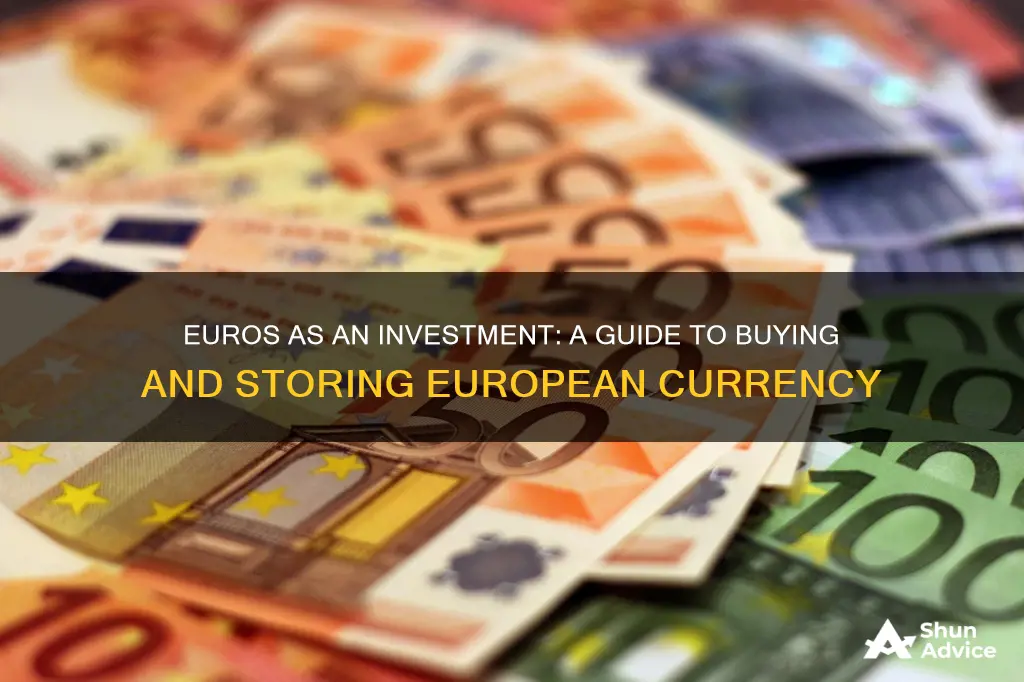
Investing in euros is a way to diversify your portfolio beyond the domestic investment market. The euro is the currency of the European Union, which was introduced in 1999 to promote stability and economic integration across Europe. While it's not adopted by every member of the European Union, many peg their local currencies to it in some way.
There are several ways to invest in euros, including:
- Exchange-traded funds (ETFs)
- Exchange-traded notes (ETNs)
- Directly through the forex market
- European mutual funds or bond funds
It's important to note that currencies are not considered viable long-term investments as they don't usually trend up over time like equities or bonds. However, if you're looking to diversify your portfolio or hedge out currency risk, investing in euros could be an option to consider.
| Characteristics | Values |
|---|---|
| Why invest in the Euro? | The Euro has appreciated against the US dollar since its inception, and investors can make money from this change. |
| How can I invest in the Euro? | By purchasing the currency itself, or through currency ETFs, European mutual funds, or forex trading. |
| Potential for gains | If the Euro strengthens against the US dollar, currency appreciation will benefit US investors holding Euros. |
| Investment opportunities | Investing in the Euro can provide access to a wide range of investment opportunities denominated in Euros, such as stocks or bonds. |
| Economic factors | Economic factors, such as interest rates, inflation, or GDP growth, affect currency movements. |
| Risks associated with the Euro | Currencies don't usually yield returns as high as equities or bonds, and they are subject to exchange rate fluctuations. |
| Expense ratios | Expense ratios for currency ETFs tend to hover around 0.64% and can eat into returns over time. |
| Volatility | Forex trading can be more volatile than the stock market, with more ups and downs. |
What You'll Learn

How to buy euros directly
If you're looking to buy euros directly, there are a few options available to you. Here are some detailed, step-by-step instructions to help you make your purchase:
Option 1: Buying Euros Before Your Trip
- Compare exchange rates offered by different currency sellers. You can use an online tool like TravelMoneyMax to find the best rates.
- Choose whether you want the euros delivered to your home or if you prefer to pick them up from a local bureau de change.
- Place your order and pay for the euros.
- If you've opted for delivery, wait for your euros to arrive. If you're picking them up, go to the selected location with your payment method of choice.
- Collect your euros and check the amount to ensure you've received the correct sum.
Option 2: Buying Euros at Your Destination
- Familiarise yourself with the local currency and exchange rates upon arrival.
- Withdraw euros from an ATM. Most European airports have ATMs readily available.
- Compare the exchange rates offered by different ATMs, as they may vary.
- Be mindful of any withdrawal fees or charges associated with using an international ATM.
- If needed, you can also exchange money at a local bank or exchange desk at major train stations or airports. However, the exchange rate may not be as favourable.
Option 3: Using a Forex Trading Account
- Open an account with a forex broker, such as FXCM Capital Markets.
- Deposit funds into your forex trading account. The minimum deposit requirements vary, but you can start with as little as $500 with some brokers.
- Buy euros using the funds in your account. Take advantage of the leverage offered by forex brokers to increase your purchasing power.
- Keep in mind that forex trading involves significant risks due to high volatility and leverage. Conduct thorough research and due diligence before entering any trades.
Option 4: Using a Multinational Corporation
- Invest in the stocks of multinational corporations with significant operations in the eurozone, such as Coca-Cola, McDonald's, IBM, or Walmart.
- By owning stock in these companies, you indirectly participate in the foreign currency market as their revenues from eurozone operations are converted back into dollars.
- This option provides a less direct way to gain exposure to the euro but can be a more stable, long-term investment strategy.
Remember that investing in currencies, especially through direct methods like forex trading, carries risks. It's important to understand the market dynamics and potential pitfalls before committing your capital. Consult with a financial professional if you're unsure about the best course of action for your specific circumstances.
Robinhood: Where to Invest Today
You may want to see also

Exchange-traded funds (ETFs)
ETFs are a good option for beginners as they are fairly simple to understand and can generate impressive returns without much expense or effort. They are also a good option if you are looking to diversify your portfolio. ETFs provide exposure to a variety of stocks, bonds, and other assets, typically at a minimal expense. They are more liquid and easier to buy and sell than mutual funds.
When choosing an ETF, it is important to consider the expense ratio, which is the cost to operate and manage the fund. ETFs with higher expense ratios can eat into returns over time. It is also important to remember that currencies are not considered viable long-term investments and that there are risks associated with investing in the forex market.
Some popular ETFs that track the euro include:
- UltraShort Euro Proshares (EUO)
- Short Euro Proshares (EUFX)
- Ultra Euro ProShares (ULE)
- Invesco CurrencyShares Euro Trust (FXE)
Smart Strategies for Investing $100K for Retirement
You may want to see also

Foreign bond funds
There is a wide range of foreign bond funds, allowing investors to select their preferred level of risk. Examples of such funds include BlackRock's Strategic Global Bond Fund, the Fidelity International Bond Index Fund, and the Vanguard Total International Bond Index Fund.
Some foreign bond funds stick to high-quality bonds from developed markets, while others invest in lower-quality bonds from developed or emerging markets. Some funds invest exclusively outside the U.S., while others invest in both U.S. and non-U.S. bonds.
VOO: Invest Now or Later?
You may want to see also

Forex trading
The foreign exchange market, or forex, is where the world's currencies are traded 24 hours a day, five days a week. It is a global marketplace for exchanging national currencies. Forex markets exist as spot (cash) and derivatives markets, offering forwards, futures, options, and currency swaps.
The forex market operates differently from a stock exchange. Currencies are traded in pairs, and the investor bets that one will appreciate while the other depreciates. The forex market is also highly liquid, meaning it's easy to buy and sell many currencies without significantly changing their value.
There are several ways to invest in the euro through the forex market. Here is a step-by-step guide to getting started with forex trading:
- Learn about forex: Understand the terminology and how the forex market operates, including currency pairs, market patterns, and the factors influencing currency prices.
- Develop a trading strategy: Learn different trading strategies, such as technical analysis, fundamental analysis, and news trading. Choose a strategy that aligns with your trading style and risk tolerance.
- Develop a plan: Create a trading plan that includes your goals, risk tolerance, strategies, and criteria for assessing trades. Stick to your plan, especially when emotions run high during trading.
- Set up a brokerage account: Select a broker regulated by a reputable financial authority, such as the Commodities Futures Trading Commission (CFTC) in the U.S. Look for a user-friendly trading platform, good customer support, and low fees.
- Practice with a demo account: Many forex platforms offer demo accounts to practice trading before risking real money. Use this opportunity to familiarize yourself with the mechanics of trading and test your strategies.
- Start slowly: Once you feel confident, start trading with real money, but start small to manage risk. Gradually increase your trading size as you gain experience.
- Stay on top of your holdings: Regularly check your positions and ensure you have enough funds in your account. Use stop-loss and take-profit orders to manage risk and protect your profits.
- Monitor and adapt: Keep up with market news, economic indicators, and geopolitical events that are likely to affect currency prices. Be prepared to adjust your strategies as market conditions change.
Some popular forex brokers include FXCM Capital Markets and FOREX.com.
It is important to note that forex trading carries significant risks. Currency values can be highly volatile and are influenced by various factors, including interest rates, inflation, geopolitical stability, and economic growth. Leverage, a common feature in forex trading, can amplify both gains and losses. Therefore, it is crucial to have a good understanding of the market, develop a solid strategy, and carefully manage your risk.
Invest or Repay: The Great Credit Conundrum
You may want to see also

Risks of investing in euros
While investing in euros can be a great way to diversify your portfolio, there are several risks to consider before making any investment decisions. Here are some key risks to keep in mind:
- Exchange-rate risk: Also known as currency risk, this occurs when the price of one currency changes relative to another. For example, if you invest in euros and the value of the euro decreases relative to the US dollar, you may lose money on your investment.
- Transaction risk: This is the risk of loss due to delays between the transaction and the settlement of trades.
- Political risk: Economic or government events can cause specific currencies to lose value. For instance, an economic crisis in Europe could cause the value of the euro to fall relative to other currencies.
- Volatility: The foreign exchange market, or forex, can be highly volatile, especially during economic downturns or periods of high geopolitical tension. This volatility can be further amplified by the high leverage used in forex trading, which can lead to significant losses.
- Lack of transparency: Due to the deregulated nature of the forex market, traders may not have access to the same level of information and transparency as they would when trading stocks.
- Complexity: Determining the price of a currency is a complex process influenced by numerous factors, making it challenging for investors to make informed decisions.
- Limited upside potential: Currencies, including the euro, typically do not trend upwards over time compared to equities or bonds. As such, they may not be suitable for long-term investments.
- Fees and expenses: Currency exchange-traded funds (ETFs) and exchange-traded notes (ETNs) often charge expense ratios, which can eat into returns over time, especially when used as a hedge.
It's important to carefully consider these risks and consult with an investment professional before investing in euros or any other foreign currency.
Tax-Free Investing: Strategies to Keep Your Profits
You may want to see also
Frequently asked questions
There are several benefits to investing in the euro. Firstly, it can provide access to a wide range of investment opportunities denominated in euros, such as stocks or bonds, allowing investors to diversify their holdings. Secondly, it can be a good hedge against currency risk, especially if you own a lot of U.S. stock. Finally, if the euro strengthens against the U.S. dollar, currency appreciation will benefit U.S. investors who hold euros.
Currencies are not considered viable long-term investments because they don't usually trend up over time as equities or bonds do. They are also subject to high volatility and significant leverage, which can magnify potential losses. Additionally, currency ETFs and ETNs tend to have high expense ratios and high turnover rates.
There are several ways to invest in the euro, including exchange-traded funds (ETFs), exchange-traded notes (ETNs), European mutual funds or bond funds, and directly through the forex market.







